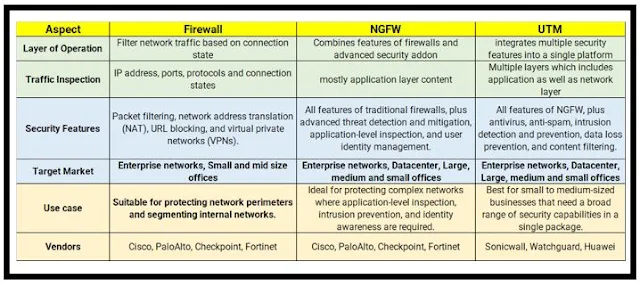Key Differences : Firewall vs NGFW Vs UTM
Key Differences : Firewall vs NGFW Vs UTM
A firewall is a network security appliance that controls and monitors network traffic using predetermined security rules. It secures sensitive data against unauthorized access or attacks by imposing access controls and monitoring network activities.
A firewall's goal is to ensure that only applicable and authorized data passes through while also blocking unwanted traffic from coming into or leaving the network.
 |
| Fig 1.1- Key Differences : Firewall vs NGFW Vs UTM |
1. Firewalls/Traditional Firewalls
A stateful firewall is one that monitors and regulates the status of network connections as they travel through it. It keeps track of each connection's data, including the source and destination IP addresses, port numbers, and its current state (open, closed, or in progress).
Based on this knowledge, the stateful firewall can make more intelligent decisions about accepting or restricting incoming and outgoing network traffic.
This type of firewall provides more security than a stateless firewall, which examines data packets without regard for the connection's context or state.
Enterprise networks and other settings requiring a high level of security frequently utilize stateful firewalls.
2. NGFW ( Next Generation Firewalls)
The abbreviation NGFW stands for Next-Generation Firewall. It is a type of firewall that offers more complex security features than traditional firewalls. Traditional firewalls were designed primarily to filter network traffic based on IP addresses, ports, and protocols.
NGFW basically has traditional firewall capabilities are integrated with new security features such as intrusion prevention, application control, URL filtering, and anti-malware protection in next-generation firewalls. As a result, NGFWs can provide more comprehensive protection against modern security threats like as malware, zero-day vulnerabilities, and advanced persistent assaults (APTs).
NGFWs are designed to monitor network traffic at the application layer, making security decisions based on traffic content rather than IP addresses, ports, and protocols.
As a result, NGFWs may block malicious traffic while allowing legitimate traffic to pass through, making them an essential component of a comprehensive security strategy.
3. UTM (Unified Threat Management)
Unified Threat Management is known as UTM. It is a kind of security system that unifies several security features such as firewall, intrusion prevention, anti-virus and anti-malware, content filtering, and VPN into a single platform.
The purpose of UTM is to reduce the difficulty of maintaining several independent security devices by offering a single point of control for various security tasks.
By combining different security functions, it also assists businesses in achieving a greater degree of security while lowering the danger of security gaps or overlap.
Small and medium-sized companies (SMBs) are frequently the target audience for UTM systems, which can be deployed as a hardware appliance, software, or cloud-based service. They offer a practical and affordable method for implementing a complete security solution to defend against a variety of security threats.
UTM components are
- Firewall
- Antivirus
- Intrusion prevention system (IPS)
- Intrusion detection system (IDS)
- Spam filtering
- Virtual private network (VPN)
- Uniform Resource Locator (URL) filtering
4. Comparing Firewall Vs. NGFW Vs. UTM
 |
| Fig 1.2- Firewall Vs. NGFW Vs. UTM |










